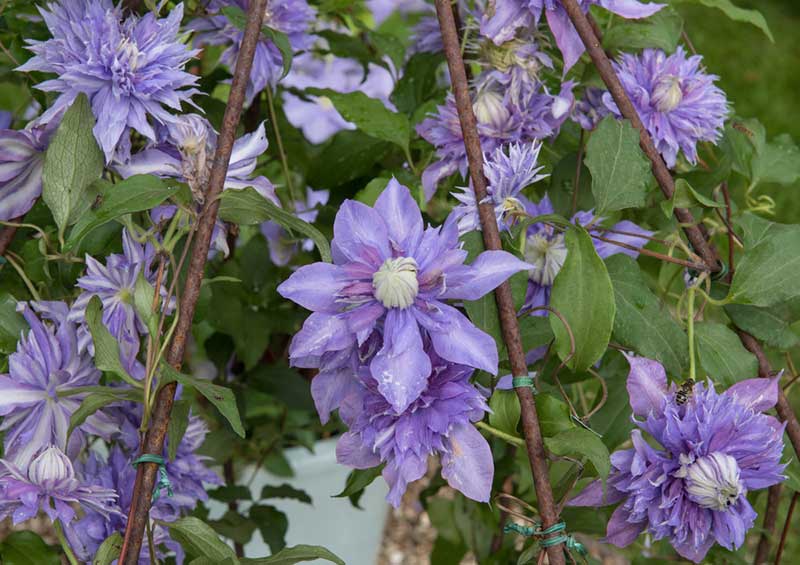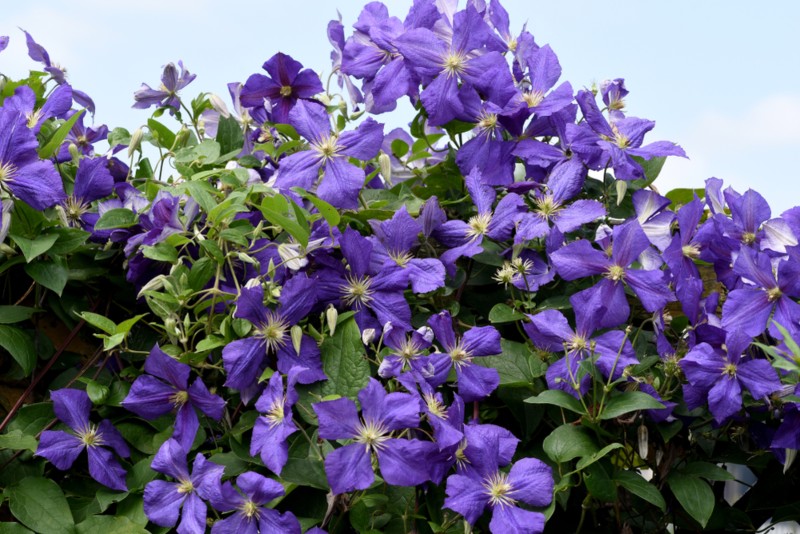
Winter is fast approaching, and as a gardener, you might be wondering what to do with your clematis vines. Should you cut them back for the winter months or leave them alone? The answer to this question depends on the type of clematis you have and its specific pruning requirements.
Clematis vines can be grouped into three main categories based on their blooming seasons: early-spring blooming, mid-spring or later blooming, and those that bloom multiple times throughout the year.
Each category has its own pruning schedule. For instance, early-spring blooming clematis should be pruned right after flowering has finished, while mid-spring or later blooming varieties should be pruned in early spring before buds swell and growth begins source.
When it comes to preparing your clematis for winter, it’s essential to follow proper pruning guidelines for your specific type. In general, you can remove any damaged, weak, or dead limbs to promote healthier growth next season.
However, avoid heavy pruning or shaping in the fall, as this may reduce the number of blooms your clematis produces the following year source.
What is Clematis?
Clematis is a genus of climbing vines that have gained popularity in gardens due to their very showy flowers and attractive, whirlwind-like seed clusters. These enchanting vines come in a variety of species, with each producing unique flowers ranging from small, delicate blooms to large, vibrant petals.
You may find clematis growing along fences, walls, trellises, or other structures, adding charm and color to your garden. Many gardeners appreciate their versatility, as these plants can thrive in different climates and environments. Clematis are hardy in USDA Zones 3-9, and some species are even suitable for growing in the colder Zone 2.

When it comes to planting and maintaining clematis, several factors come into play. The plant’s bloom time should dictate when and how to prune clematis. Pruning will help ensure a healthy plant and an impressive display of flowers in the following seasons.
As winter approaches, it is also essential to take care of your clematis to ensure their survival during the colder months. Preparing your clematis for winter may involve winter pruning and providing a generous layer of mulch around the base of the plant to protect it from freezing temperatures.
Now that you have a brief introduction to clematis, you can enjoy their captivating beauty in your garden and ensure their proper care throughout the year.
Understanding Clematis Life Cycle
Clematis plants are known as the “queen vines” and can have different blooming periods depending on the group they belong to 1. By understanding the life cycle of your clematis plant, you can provide the appropriate care for your clematis during each season.
Spring Blossoming
In the spring, clematis plants awaken from their winter dormancy and begin to grow new shoots, leaves, and blooms. Early flowering clematis plants, known as Group 1, will display their beautiful flowers on old wood during this period. It’s essential to monitor your plant’s growth and ensure it receives sufficient water, nutrients, and light during this stage of development.
Summer Growth
As the weather warms up, your clematis will continue to grow and thrive. Depending on its group classification, some varieties may begin to flower during summer as well. Group 2 clematis plants tend to produce blooms on a combination of both old and new wood, while Group 3 clematis flowers mostly on new wood. During this time, it is crucial to continue providing optimal care by regular watering, fertilizing, and checking for pests or diseases.
Autumn Shedding
As the weather cools down in autumn, the clematis plant will gradually begin to shed its leaves and flowers in preparation for winter dormancy. During this phase, it’s essential to keep an eye out for any dead stems and trim them off if necessary, especially if they are adding too much weight on healthy stems, which could be encumbered by snow or ice.
Winter Dormancy
During winter, clematis plants enter a dormant state to withstand the cold weather. It is during this period that some clematis plants, particularly Group 3, require pruning to stimulate vigorous growth in the following spring. Pruning clematis during winter can help maintain the plant’s overall health and shape, ensuring a beautiful and bountiful display of blooms in the upcoming season.
To Prune or Not to Prune
Debate on Pruning
There’s an ongoing debate among gardeners about whether or not you should cut back clematis for the winter. Some argue that pruning in the fall has significant benefits such as promoting strong growth and preventing potential damage from harsh winter weather. However, there are also drawbacks to cutting back clematis during the fall, as it may be unnecessary for certain clematis varieties and could even lead to a loss of seasonal blooms1.
Factors Affecting Pruning Decision
To make the most informed decision about pruning clematis, consider the following factors:
- Clematis Type: There are different pruning groups for clematis, including those that bloom in winter, spring, or summer. The decision to prune depends heavily on the flowering season and the specific needs of the clematis variety you have.
- Age of the Plant: The age of your clematis vine plays a crucial role in determining the necessity of pruning. Younger plants (one to three years old) may benefit from hard pruning to encourage stronger growth and a fuller appearance.
- Plant Health: Inspect your clematis for any signs of damage or disease. If you spot brown, damaged, or dead areas, you may need to prune back the affected parts to promote overall plant health.
- Growth Space: If your clematis has plenty of space to grow, it may not require pruning at all. Some winter and spring-flowering clematis varieties can be left alone if they have ample room in the garden.
In conclusion, the decision to prune clematis in the fall depends on several factors like the specific variety, plant age, and overall health of the plant. Ultimately, you should tailor your pruning approach to meet the unique needs of your clematis and garden.

How to Prune Clematis for Winter
Choosing the Right Time
To ensure healthy and vigorous growth, it’s essential to prune your clematis at the right time. Different groups of clematis have specific pruning needs. For instance, Group 1 clematis blooms on the previous year’s growth and should be pruned after flowering in mid- to late spring[^2^]. In contrast, large-flowered clematis that flower in early summer should be pruned lightly in late winter or early spring[^4^].
Tools for Pruning
Before you begin pruning, make sure you have the appropriate tools at your disposal. A good pair of secateurs is essential for making clean, sharp cuts that minimize plant damage. Other helpful tools may include gloves, a pruning saw, and garden ties to support the vines as they grow[^3^].
Steps in Pruning
- Start by identifying the type of clematis you have, as this will determine the appropriate pruning method[^1^].
- For Group 3 clematis, which flower in late summer, untangle the previous year’s growth from its support and remove any strings or ties used for training[^3^].
- Cut back the stems to about 30cm (12 inches) above a bud[^4^].
- For early summer bloomers, cut a couple of stems down to the first bud to encourage lower growth and trim the rest back by 30cm (12in) above a bud[^4^].
Post-Pruning Care
After pruning your clematis, it’s important to provide proper care to ensure the plant thrives during the winter. Once the ground freezes or the air temperature drops to 25 degrees F (-3 C), place a generous layer of mulch around the base and crown of your clematis. This will help protect the plant from harsh winter temperatures and provide nutrients for healthy growth. Suitable materials for mulching include straw, hay, manure, leaf mold, grass clippings, and commercial mulch.

Potential Risks of Winter Pruning
Unhealthy Regrowth
When you prune clematis plants in winter, it may negatively affect their growth in the following season. The cuts made can stimulate the plant to produce new growth that can be weak and misshapen, as they struggle to repair themselves during the colder months. This unhealthy regrowth may cause the plant to become less vigorous and produce fewer blooms in spring and summer. To preserve the plant’s health, it’s better to prune spring and multi-blooming clematis only to remove damaged, weak or dead limbs during fall.
Vulnerability to Frost
Pruning your clematis during winter might leave them susceptible to frost damage. New growth that emerges as a result of winter pruning can be fragile and easily damaged by freezing temperatures. Tender shoots can be particularly vulnerable, as they may not have enough time to harden off before the frost sets in. To safeguard your plants from frost damage, you should consider pruning Group 3 clematis – those that flower in late summer – as they require regular pruning and will grow flowers on the current year’s growth. However, for other types of clematis, minimally prune in fall or wait until late winter or early spring for a more suitable time to prune.
Remember, it is your responsibility to ensure proper care for the plants in your garden, and understanding the risks associated with winter pruning can help you make informed decisions for their health and growth.
Alternatives to Winter Pruning
Pruning clematis in the winter is not the only way to maintain the plant. There are alternative approaches to consider based on the variety of your clematis and your personal preferences.
One popular alternative is pruning in the spring. This method is especially beneficial for spring and multi-blooming clematis. In the fall, you only need to remove damaged, weak, or dead limbs. Light shaping can be done, but be cautious not to cut off any potential blooms for the next year.
Another option is to leave the clematis unpruned. This might be suitable for certain varieties or if your clematis is relatively young. As suggested by Ruth Gooch, in her book “Clematis The Complete Guide,” you could hard prune all one- to three-year-old clematis down to the second set of strong buds above ground level. Be aware that this method may sacrifice most flowers if the plant is a spring-bloomer.
In addition to these alternatives, other tips for maintaining your clematis before winter include:
- Untangling the growth and removing any old stems or shoots
- Spreading out the stems around the plant’s base to promote even growth
- Add a layer of mulch around the plant to keep it warm during the winter
By exploring these alternatives, you can select the best approach for taking care of your clematis in different seasons and ensure its health and beautiful blooming.

Conclusion
In summary, it’s essential to properly prepare your clematis for winter to ensure its optimum health and growth. The decision to cut back your clematis mainly depends on the type of clematis you have. Not all clematis plants require regular pruning, and the timing for trimming varies, depending on their blooming season.
For early-spring blooming varieties, it is best to prune right after flowering has finished. On the other hand, if your clematis blooms in mid-spring or later, the ideal time to prune is in early spring before buds swell and growth begins.
As a general best practice, it’s a good idea to clean up any dead leaves and flowers in the fall to help the plant thrive during the winter months. Ensure that you snip off spent blooms using clean, sharp garden scissors to avoid potential infections.
A friendly reminder: when pruning, be gentle with your clematis as they can be fragile, and avoid making exaggerated cuts. Your attentive care will ultimately lead to a healthier, more vibrant clematis, ready to bloom brilliantly once the warmer months arrive. Have fun tending to your clematis, and enjoy the beautiful results!














